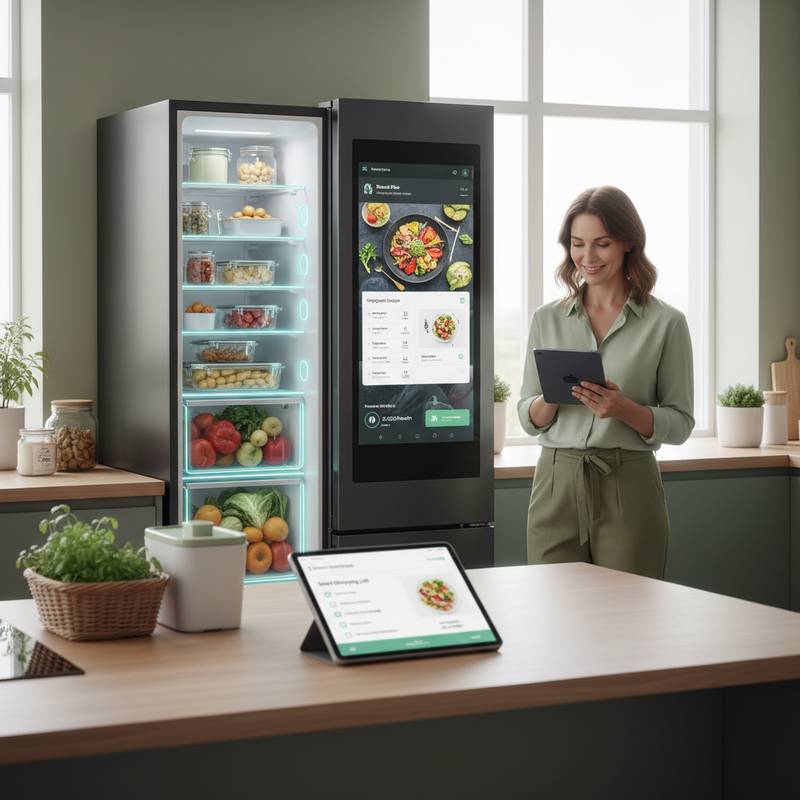AI Refrigerators Reduce Household Food Waste by Half
Nearly every household encounters the frustration of spoiled food. Opened refrigerators often reveal wilted spinach, overlooked leftovers, or yogurt past its expiration date. Food waste represents a significant inefficiency in modern living, with economic and environmental consequences. The latest AI-powered smart refrigerators address this issue through vision recognition, ingredient tracking, and meal planning suggestions, reshaping shopping, cooking, and kitchen management practices.
Smart home devices evolve from mere conveniences into sustainable systems. AI refrigerators exemplify this shift, acting as proactive partners rather than passive storage units. These appliances now analyze contents, forecast usage, and provide reminders to maximize existing ingredients.
Limitations of Conventional Refrigerators
Conventional refrigerators function primarily as cooling units. They preserve food temperature but offer no assistance in monitoring or utilizing contents effectively. Consequently, families discard produce, dairy, and leftovers hidden on shelves, leading to substantial waste.
Studies indicate that a considerable percentage of purchased food goes uneaten in households. This waste accumulates, costing families hundreds of dollars annually and straining resources unnecessarily. The core problem stems from a gap between purchases and meal preparation. Hectic schedules cause oversights in inventory and a lack of ideas for using available items, resulting in excess buying and underutilized supplies.
Introduction to AI-Equipped Refrigerators
AI refrigerators disrupt this cycle with advanced tracking and predictive capabilities. Equipped with internal cameras, sensors, and machine learning, they catalog items upon door closure, noting expiration dates and quantities. The system generates meal ideas prioritizing soon-to-expire ingredients, curates shopping lists, and integrates with delivery services for seamless restocking.
This approach extends beyond adding interfaces; it fosters an adaptive kitchen environment. Consider a refrigerator that maintains optimal temperatures while notifying users about perishable berries and proposing a smoothie recipe to incorporate them promptly.
Mechanics of AI-Driven Meal Planning
AI meal planning relies on accessible yet robust technology. Cameras and barcode readers compile a digital inventory of fridge contents. Cloud processing then cross-references this data against extensive recipe libraries, factoring in freshness, user preferences, and nutritional objectives.
For example, detection of chicken, spinach, and tomatoes might yield suggestions for pasta primavera or a fresh salad. Leftover portions from prior meals prompt ideas for repurposing, such as stir-fries or casseroles. Integration with voice assistants enables queries like "What options exist for tonight's dinner?" with customized responses delivered instantly.
Over time, the system adapts to household patterns, such as milk consumption rates or vegetable preferences, refining suggestions for accuracy. Compatibility with ovens or displays delivers sequential cooking guidance, streamlining preparation.
Minimizing Waste Through Targeted Strategies
AI refrigerators excel at slashing food waste by promoting proactive ingredient use. Expiration monitoring ensures timely consumption, diminishing forgotten items and associated remorse. Households experience reduced spoilage across categories like fruits, vegetables, and proteins.
Enhanced purchasing decisions further amplify savings. Mobile app connectivity produces precise shopping lists, identifying gaps without redundancies. If eggs and butter stock the shelves, recommendations exclude duplicates, curbing impulse buys and aligning expenditures with budgets.
Advanced models quantify sustainability impacts, displaying saved food volumes or emission reductions from avoided waste. Such metrics transform abstract environmental goals into concrete achievements, motivating consistent adoption.
Pioneering Implementations in the Market
Leading manufacturers incorporate these features into high-end refrigerators. Certain models deploy cameras for content analysis, syncing visuals to apps for remote viewing without door access. Others advance to precise ingredient identification, connecting to recipe aggregators and meal kit providers.
One innovator scans expiration labels to issue timely alerts via notifications. Another partners with retailers for automated replenishment of staples like milk or bread. These developments illustrate AI meal planning's transition from experimental to essential functionality.
Market forecasts anticipate broader accessibility as costs decline and integrations standardize. Consumer interest, fueled by efficiency and ecological priorities, accelerates this momentum.
Integrating Technology into Everyday Routines
Advanced features enhance daily experiences without overwhelming users. Parents discover rapid meal solutions, bypassing extensive online searches. Individuals focused on wellness receive balanced proposals aligned with specific diets, such as low-carb or vegan options.
Even reluctant cooks benefit from guided prompts that simplify processes. The underlying satisfaction arises from efficient resource use, financial prudence, and waste avoidance, embedding eco-conscious practices seamlessly.
Addressing Potential Drawbacks
AI refrigerators present hurdles alongside advantages. Premium pricing exceeds basic models, though market dynamics promise affordability improvements. Privacy issues arise from cloud-stored data on consumption behaviors, prompting manufacturers to enhance encryption and opt-out options.
Recognition accuracy depends on factors like illumination and arrangement; obscured items may evade detection. Ongoing refinements in algorithms and manual override features mitigate these inconsistencies.
Future interoperability with pantries, appliances, and apps will elevate performance, creating cohesive smart kitchen networks.
Environmental and Societal Ramifications
Aggregate waste reductions across households yield profound effects. Diminished discards lessen packaging needs, transport demands, and landfill burdens. Food production's ecological footprint shrinks correspondingly, conserving water, land, and energy.
In dense urban settings, these tools promote compact, efficient living. Intentional procurement and inventive meal assembly foster mindful habits, contributing to widespread shifts in consumption norms.
Steps to Adopt AI Meal Planning
Prospective buyers should evaluate key attributes: robust recognition technology, intuitive applications, and harmony with current smart devices. Modular options allow feature additions to existing units, easing entry.
Basic alerts for expirations and recipe prompts deliver immediate waste reductions. Users often report more deliberate shopping and inventive cooking, yielding long-term efficiencies.
Achieving Efficient, Sustainable Kitchens
AI refrigerators empower households to optimize resources and embrace sustainability. By bridging planning gaps, they convert routine tasks into opportunities for savings and environmental stewardship. This evolution positions kitchens as hubs of intelligent, responsible living.
